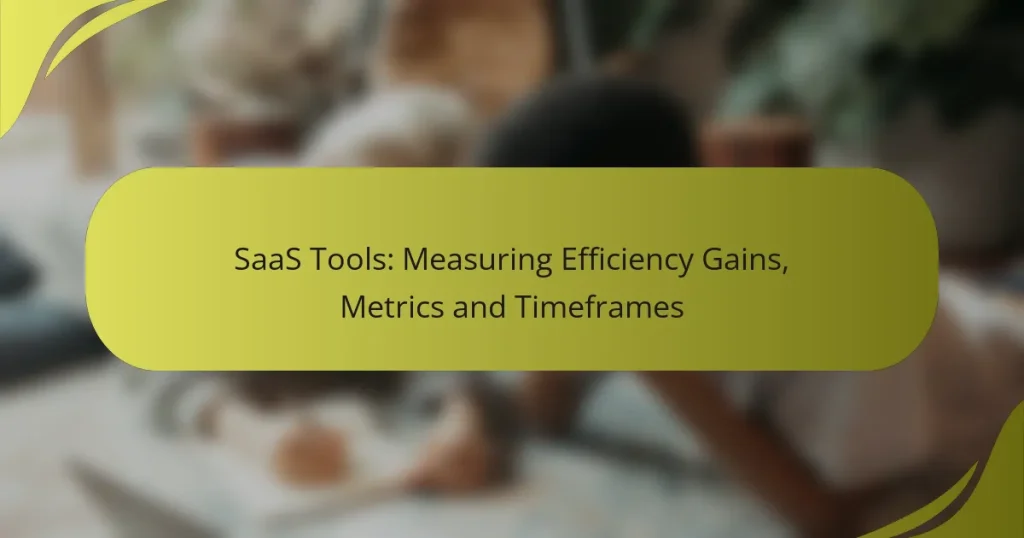In the rapidly evolving landscape of Software as a Service (SaaS), measuring efficiency gains is crucial for organizations aiming to enhance productivity and operational effectiveness. By tracking performance metrics, user feedback, and workflow automation, businesses can gain valuable insights into the impact of their SaaS solutions. Understanding key metrics such as customer acquisition cost and churn rate, along with appropriate timeframes for assessment, enables informed decision-making and strategic growth.
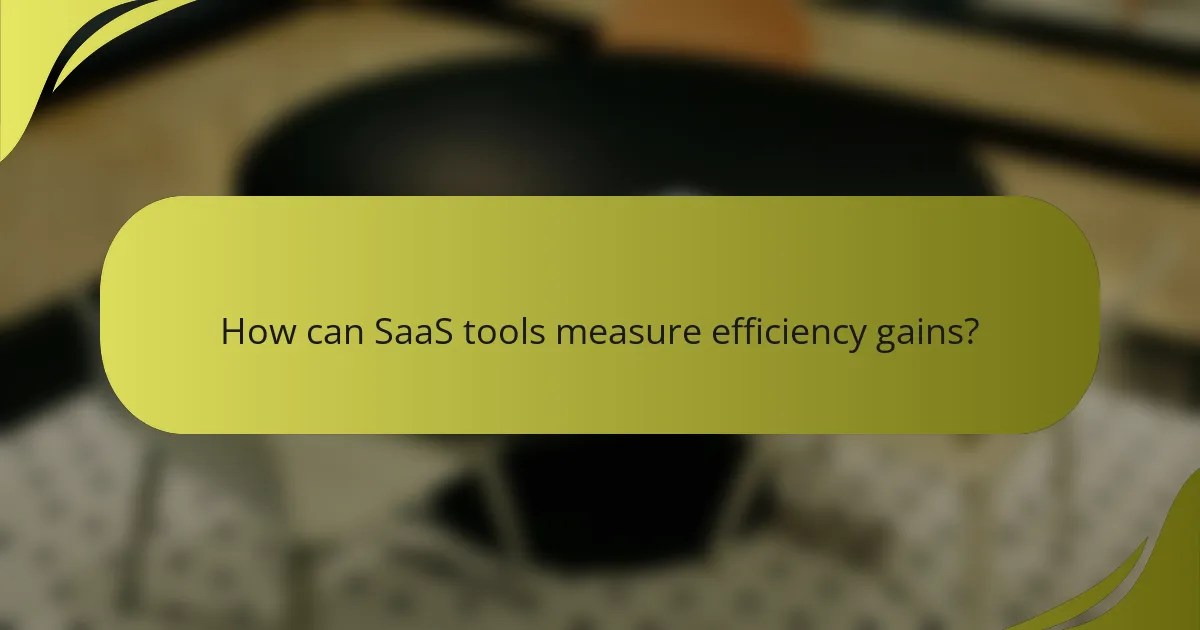
How can SaaS tools measure efficiency gains?
SaaS tools can measure efficiency gains by tracking various performance metrics, user feedback, workflow automation, time savings, and industry benchmarks. These measurements help organizations understand the impact of SaaS solutions on productivity and operational effectiveness.
Utilizing performance metrics
Performance metrics are essential for evaluating the effectiveness of SaaS tools. Key metrics include user adoption rates, task completion times, and error rates. By regularly monitoring these indicators, businesses can identify areas for improvement and assess the overall performance of their SaaS solutions.
For example, if a tool shows a significant drop in task completion times after implementation, it may indicate improved efficiency. Establishing baseline metrics before adopting a SaaS tool allows for clearer comparisons over time.
Implementing user feedback
User feedback is a valuable resource for measuring efficiency gains. Collecting insights through surveys, interviews, or usability tests helps identify pain points and areas where the tool excels. This feedback can guide further enhancements and ensure the tool meets user needs effectively.
Encouraging regular feedback sessions can foster a culture of continuous improvement. Consider implementing a structured feedback loop where users can share their experiences and suggestions for enhancements.
Analyzing workflow automation
Workflow automation is a critical aspect of SaaS tools that can lead to significant efficiency gains. By automating repetitive tasks, businesses can reduce manual effort and minimize errors. Analyzing the extent of automation can reveal how much time and resources are saved.
For instance, if a SaaS tool automates data entry and reduces the time spent on this task from hours to minutes, the efficiency gain is substantial. Regularly reviewing automated processes ensures they remain effective and aligned with business goals.
Tracking time savings
Time savings are a straightforward measure of efficiency gains from SaaS tools. Organizations can track the time spent on specific tasks before and after implementing a SaaS solution. This comparison highlights the direct impact of the tool on productivity.
For example, if a project management tool reduces project planning time from several days to just a few hours, this quantifiable time saving can justify the investment in the tool. Documenting these time savings can also support future decision-making regarding tool adoption.
Benchmarking against industry standards
Benchmarking against industry standards provides context for measuring efficiency gains. By comparing performance metrics with those of similar organizations, businesses can assess their relative efficiency. This practice helps identify best practices and areas where they may lag behind competitors.
For instance, if the average task completion time in the industry is significantly lower than a company’s current performance, it may indicate a need for improvement. Utilizing industry reports and studies can provide valuable benchmarks for comparison.
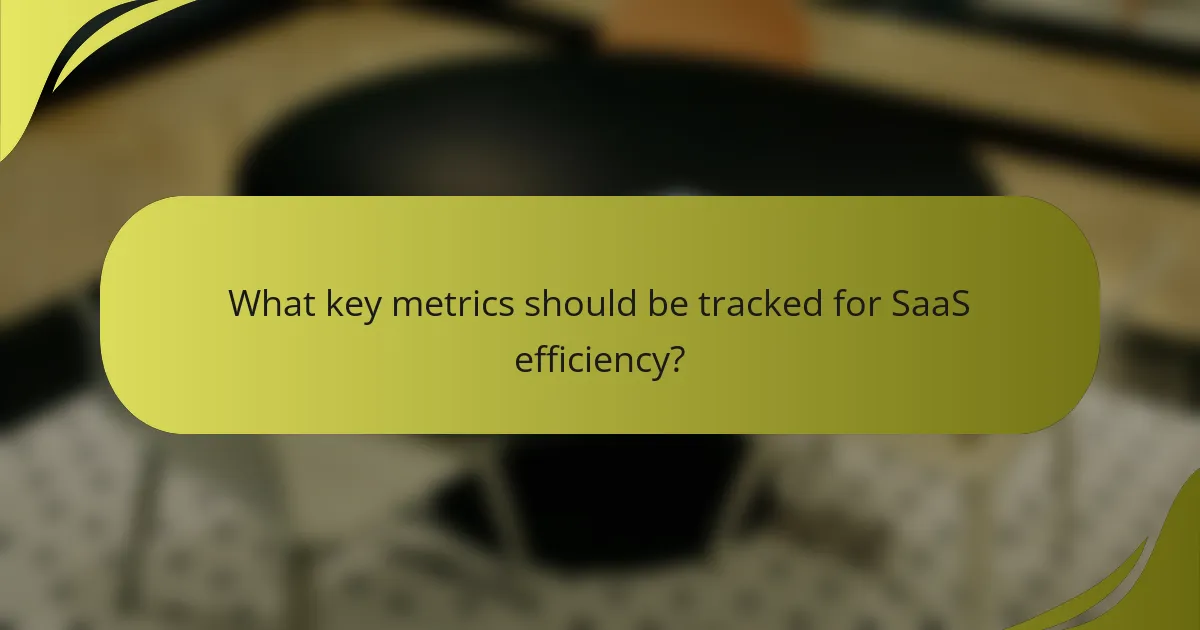
What key metrics should be tracked for SaaS efficiency?
Tracking key metrics for SaaS efficiency is essential for understanding the performance and growth potential of your software service. Focus on metrics like customer acquisition cost, monthly recurring revenue, churn rate, and net promoter score to gauge efficiency and make informed decisions.
Customer acquisition cost (CAC)
Customer acquisition cost (CAC) measures the total cost of acquiring a new customer, including marketing expenses, sales team salaries, and any promotional costs. A lower CAC indicates a more efficient acquisition strategy, which is crucial for profitability.
To calculate CAC, divide total acquisition costs by the number of new customers gained in a specific period. For example, if you spend $10,000 to acquire 100 customers, your CAC is $100. Aim for a CAC that is significantly lower than the lifetime value (LTV) of your customers to ensure sustainable growth.
Monthly recurring revenue (MRR)
Monthly recurring revenue (MRR) is a key metric that reflects the predictable revenue generated from subscriptions each month. MRR provides insights into your business’s financial health and growth trajectory.
To calculate MRR, sum the recurring revenue from all active subscriptions. For instance, if you have 50 customers paying $50 per month, your MRR would be $2,500. Tracking MRR helps you identify trends and make strategic decisions regarding pricing and customer retention.
Churn rate
The churn rate indicates the percentage of customers who cancel their subscriptions within a given timeframe. A high churn rate can signal issues with customer satisfaction or product fit, making it a critical metric to monitor.
To calculate churn rate, divide the number of customers lost during a period by the total number of customers at the beginning of that period. For example, if you start with 200 customers and lose 10, your churn rate is 5%. Aim to keep churn rates below 5% to maintain a healthy customer base.
Net promoter score (NPS)
Net promoter score (NPS) measures customer loyalty and satisfaction by asking customers how likely they are to recommend your service to others. A higher NPS indicates a more engaged and satisfied customer base.
To calculate NPS, survey customers and categorize their responses into promoters, passives, and detractors. Subtract the percentage of detractors from the percentage of promoters to get your NPS. For example, if 70% are promoters and 10% are detractors, your NPS is 60. Regularly track NPS to identify areas for improvement and enhance customer experience.

What timeframes are typical for measuring SaaS efficiency gains?
Typical timeframes for measuring SaaS efficiency gains vary based on the specific goals and metrics being tracked. Generally, short-term assessments occur within a few months, while medium and long-term evaluations extend to six months or more, allowing for a comprehensive understanding of performance improvements.
Short-term (1-3 months)
In the short term, businesses can assess immediate impacts of SaaS tools on productivity and operational efficiency. Key metrics to consider include user adoption rates, initial cost savings, and early feedback from team members. For example, if a new project management tool is implemented, tracking the number of tasks completed within the first month can provide quick insights into its effectiveness.
Common pitfalls during this phase include overemphasizing initial results without considering longer-term trends. It’s crucial to set realistic expectations and focus on qualitative feedback alongside quantitative metrics.
Medium-term (3-6 months)
Medium-term evaluations allow for a deeper analysis of SaaS efficiency gains, focusing on sustained performance improvements and ROI. During this period, businesses should measure metrics such as time saved on tasks, reduction in operational costs, and overall team productivity. For instance, if a customer relationship management (CRM) system is adopted, tracking the increase in sales conversions over several months can highlight its effectiveness.
At this stage, it’s beneficial to compare results against initial benchmarks established during the short-term assessment. This comparison helps identify trends and areas needing adjustment, ensuring that the SaaS tool continues to meet business objectives.
Long-term (6-12 months)
Long-term assessments provide a comprehensive view of the SaaS tool’s impact on the organization. This timeframe allows for the evaluation of strategic goals, such as customer satisfaction and employee retention, alongside financial metrics like total cost of ownership. For example, analyzing customer churn rates after implementing a support platform can reveal significant insights into its effectiveness over time.
When measuring long-term gains, consider conducting regular reviews and updates to the metrics being tracked. This ensures that the evaluation remains aligned with evolving business goals and market conditions. Engaging stakeholders in this process can also foster a culture of continuous improvement and adaptation.
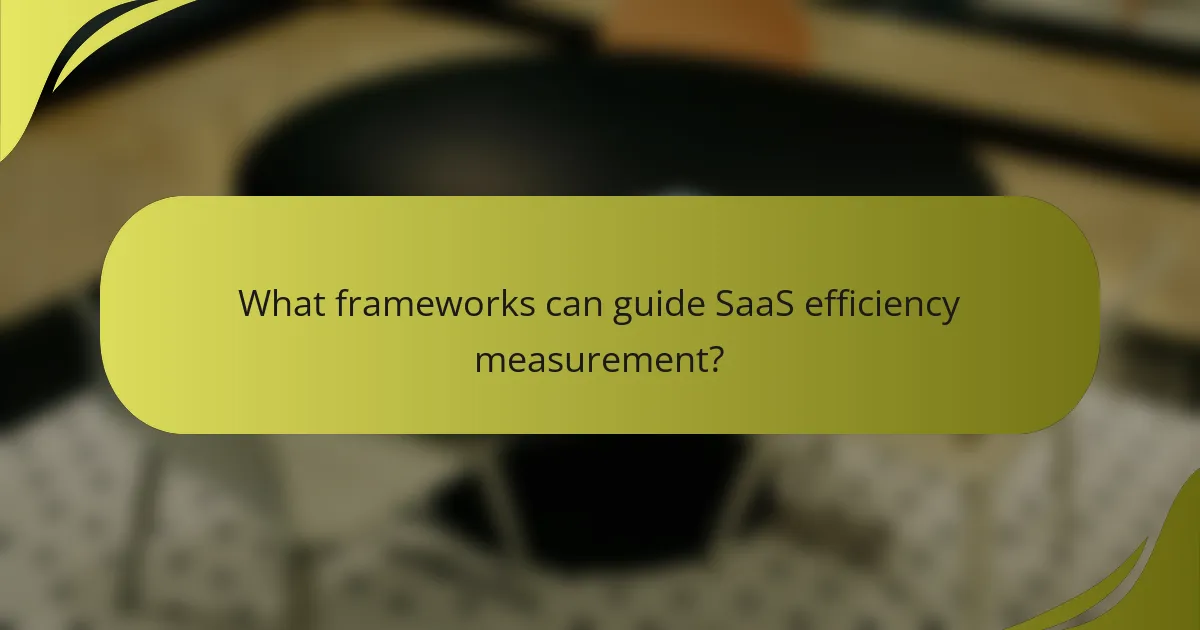
What frameworks can guide SaaS efficiency measurement?
Frameworks like OKRs and KPIs are essential for measuring efficiency in SaaS tools. They provide structured methods to set goals, track performance, and evaluate the impact of software on business operations.
OKR (Objectives and Key Results)
OKRs help organizations set clear objectives and measurable key results to track progress. This framework encourages alignment and focus across teams, making it easier to gauge how SaaS tools contribute to overall goals.
To implement OKRs effectively, define 3-5 objectives that are ambitious yet achievable, along with 2-5 key results for each objective. For example, an objective might be to improve customer satisfaction, with key results like reducing response time to under 2 hours.
Common pitfalls include setting too many objectives or vague key results. Ensure that each objective is specific and that key results are quantifiable to maintain clarity and accountability.
KPIs (Key Performance Indicators)
KPIs are quantifiable metrics that reflect the performance of a SaaS tool in achieving business objectives. They provide insights into operational efficiency and help identify areas for improvement.
When selecting KPIs, focus on those that align with your business goals. For instance, if your goal is to increase user engagement, relevant KPIs might include daily active users or average session duration. Aim for a balance of leading and lagging indicators to get a comprehensive view.
Be cautious of relying solely on vanity metrics, which may look good but don’t provide actionable insights. Instead, prioritize KPIs that directly impact decision-making and reflect true performance. Regularly review and adjust your KPIs to ensure they remain relevant as business needs evolve.
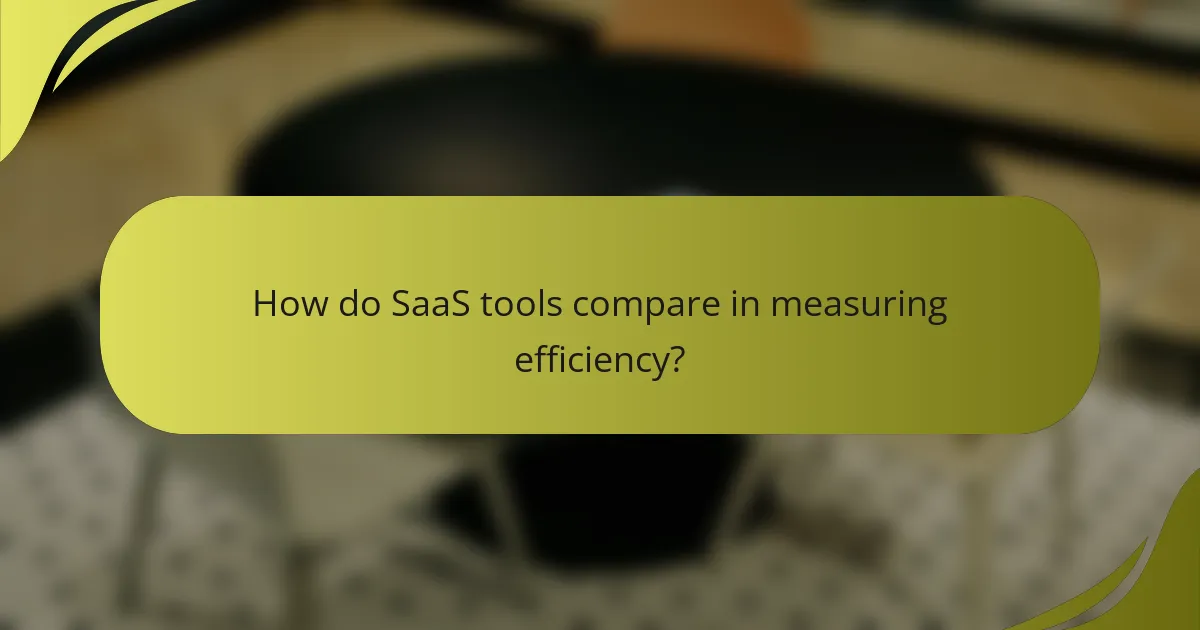
How do SaaS tools compare in measuring efficiency?
SaaS tools vary significantly in how they measure efficiency, often focusing on different metrics and user experiences. Understanding these differences can help businesses select the right tool to optimize workflows and enhance productivity.
Comparison of Asana and Trello
Asana and Trello both offer unique approaches to measuring efficiency. Asana provides detailed project tracking and reporting features, allowing teams to analyze task completion rates and project timelines. In contrast, Trello uses a visual card-based system that emphasizes workflow management, making it easier to see task progress at a glance.
When choosing between these tools, consider your team’s workflow style. Asana is better suited for complex projects requiring detailed tracking, while Trello excels in simpler, more visual task management. A common pitfall is underestimating the need for reporting capabilities, which can be crucial for understanding efficiency gains.
Efficiency metrics in HubSpot vs. Salesforce
HubSpot and Salesforce both provide robust metrics for measuring efficiency, but they cater to different business needs. HubSpot focuses on marketing and sales alignment, offering metrics like lead conversion rates and customer engagement scores. Salesforce, on the other hand, emphasizes sales performance with metrics such as sales cycle length and win rates.
To effectively measure efficiency, businesses should align their choice of tool with their primary objectives. For instance, if your goal is to enhance marketing efforts, HubSpot’s metrics may be more beneficial. Conversely, if sales performance is the focus, Salesforce’s detailed analytics will provide deeper insights. Avoid the mistake of using both tools without a clear strategy, as this can lead to data fragmentation and confusion.

What are the benefits of measuring efficiency in SaaS tools?
Measuring efficiency in SaaS tools provides insights into performance, cost savings, and user satisfaction. By tracking key metrics, organizations can identify areas for improvement and optimize their workflows, ultimately leading to enhanced productivity.
Key Metrics to Consider
When measuring efficiency in SaaS tools, focus on metrics such as user adoption rates, task completion times, and cost per user. These indicators help assess how effectively the tools are being utilized and can highlight potential bottlenecks in processes.
For example, if user adoption rates are low, it may indicate a need for better training or support. Similarly, tracking task completion times can reveal whether a tool is speeding up workflows or causing delays.
Timeframes for Measuring Efficiency Gains
Efficiency gains from SaaS tools can typically be measured over short to medium timeframes, often within weeks to a few months. Initial improvements may be seen quickly, but more substantial gains usually require ongoing assessment and adjustment.
Establishing a baseline before implementing a new tool is essential. After a few weeks of use, compare current metrics against the baseline to evaluate progress and make informed decisions about further optimizations.
Common Pitfalls to Avoid
One common pitfall is failing to define clear objectives before measuring efficiency. Without specific goals, it can be challenging to determine whether a tool is delivering value. Additionally, relying solely on quantitative metrics without considering qualitative feedback can lead to an incomplete picture.
Another mistake is neglecting to involve end-users in the evaluation process. Their insights can provide valuable context and help identify issues that metrics alone may not reveal.
